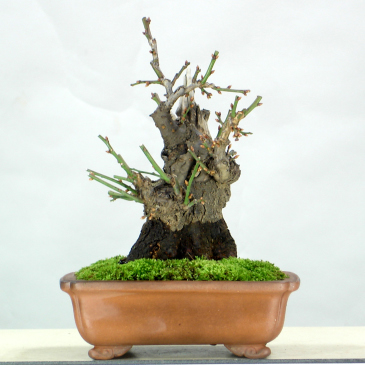Bonsai Nut
Nuttier than your average Nut
An interesting tree currently for sale at Bonsai Hokaen. Can't say that I really like it - the trunks feel too straight and lack taper (for me). At any rate, it is an uncommon style for black pines.






Chris you mean the right,, right?
A Friend in bonsai
John
If someone was really interested and had the money to buy the tree as it is now there is a possibility. If you look at the tree and you have followed Pine techniques in the major publications you have probably come to the conclusion that this tree was created from an air layering at the top of a larger tree that was being chopped down to make a quality bonsai. It would be possible to air layer off one or two of the existing trunks and jin the remaining stubs. I know---When in wonder, when in doubt, air layer. But if anyone has a better idea I would like to hear it.
As the tree exists now the choices are not real good and will take decades to bear fruit.
What leads you to the conclusion that this is an air layer? The nebari alone would seem to me to be evidence to the contrary. And if we air layer two trunks, or even chop two, which two and how would you fix the strange swelling at the base?
So suppose you air or ground layer, as Will has shown. That would be an obvious jump in the quality and value of this tree. I suppose the middle trunk could be encouraged and the too-large one held back. Perhaps in a few years it would be a great tree. How long for the whole process? Ten years? More? Might be worth it.
And how much money would it take to buy this tree? Is there a price on the website? Would it be worth importing from Japan?
Will,
nice job indeed!
But think if this was your tree and in 10 to 20 years from now all those trunks at the bottom was to grow as one? The trunk on the left is a bit bigger now but will it be in the future? The middle trunk is now the main trunk and dominating one, now it is getting all the strength and will dominate. So in the future it will be a complete and different tree. The owner may be thinking along these lines thinking that his son or daughter will keep it going on. So just to look at a photo now may not mean that it will be the photo later?
I don't know for sure that this tree is the product of an air layer but I remember quite a few years ago when an abundance of articles circled around concerning the Zuisho Japanese White Pine. There were several references and photos of trees that were to be reduced. Rather than simply cut the top out, the tops were air layered. It was this type of configuration that was the by product of that procedure. The oddly swollen base seems to add credence to this probability. Do I think the tree is worth the probable asking price to import from Japan. No, personally I have no interest in this particular tree. That does not mean that it may be of great value to someone else.
